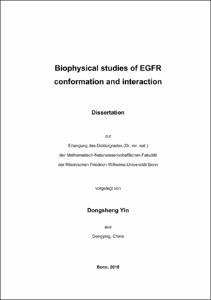Yin, Dongsheng: Biophysical studies of EGFR conformation and interaction. - Bonn, 2019. - Dissertation, Rheinische Friedrich-Wilhelms-Universität Bonn.
Online-Ausgabe in bonndoc: https://nbn-resolving.org/urn:nbn:de:hbz:5-53947
Online-Ausgabe in bonndoc: https://nbn-resolving.org/urn:nbn:de:hbz:5-53947
@phdthesis{handle:20.500.11811/7890,
urn: https://nbn-resolving.org/urn:nbn:de:hbz:5-53947,
author = {{Dongsheng Yin}},
title = {Biophysical studies of EGFR conformation and interaction},
school = {Rheinische Friedrich-Wilhelms-Universität Bonn},
year = 2019,
month = mar,
note = {Epidermal growth factor receptor (EGFR) plays such a crucial role in cell signaling that its activity is intricately regulated. According to the prevailing activation model, EGF binding to EGFR initiates a series of structural rearrangements, leading to allosteric activation of the kinase domain. During this process the oligomeric state of the kinase is promoted from monomer or inactive (symmetric) dimer to active (asymmetric) dimer. Due to the direct correlation with kinase activity, asymmetric/symmetric dimers are key to this activation model, and therefore have been extensively studied via crystallography and negative-stain electron microscopy. However, high-resolution structural description of these entities in solution is still lacking. Here, via pulsed electron-electron double resonance (PELDOR) spectroscopy, a number of different EGFR constructs are shown to exist in solution in a single oligomeric form that reflects asymmetric dimerization as reported in crystallization studies. Mutagenesis and analytical gel filtration studies corroborate this dimeric arrangement. Notably, a new approach to label proteins for PELDOR studies, i.e. inhibitor-directed spin labeling, has been established in this pilot study of EGFR, which exemplifies its potential for a more general application in PELDOR-based protein conformation studies. Beyond the well-established model of receptor-intrinsic control of the allosteric activation mechanism, evidence is accumulating for an additional layer of regulation of EGFR activity by less well-understood cytoplasmic modulators. Therefore, the second part of this thesis is devoted to investigating interaction of EGFR with Arf nucleotide-binding site opener (ARNO), a potential activator, via microscale thermophoresis (MST) and nuclear magnetic resonance (NMR) studies. MST assays not only reveal EGFR:ARNO interaction, but also identify the recognition elements as the Sec7 domain of ARNO and the juxtamembrane (JM) segment of EGFR. Competition experiments demonstrate that calmodulin, another EGFR activity modulator, targets the same or a similar binding site in JM yet with stronger affinity compared to Sec7. NMR studies characterize the amino acids of Sec7 and JM that are involved in their interaction and narrow down the binding sites of Sec7 and calmodulin to the same N-terminal region in JM. To integrate the results of these studies into the current view of EGFR signaling an "endocytosis hypothesis" and a "priming hypothesis" are presented.},
url = {https://hdl.handle.net/20.500.11811/7890}
}
urn: https://nbn-resolving.org/urn:nbn:de:hbz:5-53947,
author = {{Dongsheng Yin}},
title = {Biophysical studies of EGFR conformation and interaction},
school = {Rheinische Friedrich-Wilhelms-Universität Bonn},
year = 2019,
month = mar,
note = {Epidermal growth factor receptor (EGFR) plays such a crucial role in cell signaling that its activity is intricately regulated. According to the prevailing activation model, EGF binding to EGFR initiates a series of structural rearrangements, leading to allosteric activation of the kinase domain. During this process the oligomeric state of the kinase is promoted from monomer or inactive (symmetric) dimer to active (asymmetric) dimer. Due to the direct correlation with kinase activity, asymmetric/symmetric dimers are key to this activation model, and therefore have been extensively studied via crystallography and negative-stain electron microscopy. However, high-resolution structural description of these entities in solution is still lacking. Here, via pulsed electron-electron double resonance (PELDOR) spectroscopy, a number of different EGFR constructs are shown to exist in solution in a single oligomeric form that reflects asymmetric dimerization as reported in crystallization studies. Mutagenesis and analytical gel filtration studies corroborate this dimeric arrangement. Notably, a new approach to label proteins for PELDOR studies, i.e. inhibitor-directed spin labeling, has been established in this pilot study of EGFR, which exemplifies its potential for a more general application in PELDOR-based protein conformation studies. Beyond the well-established model of receptor-intrinsic control of the allosteric activation mechanism, evidence is accumulating for an additional layer of regulation of EGFR activity by less well-understood cytoplasmic modulators. Therefore, the second part of this thesis is devoted to investigating interaction of EGFR with Arf nucleotide-binding site opener (ARNO), a potential activator, via microscale thermophoresis (MST) and nuclear magnetic resonance (NMR) studies. MST assays not only reveal EGFR:ARNO interaction, but also identify the recognition elements as the Sec7 domain of ARNO and the juxtamembrane (JM) segment of EGFR. Competition experiments demonstrate that calmodulin, another EGFR activity modulator, targets the same or a similar binding site in JM yet with stronger affinity compared to Sec7. NMR studies characterize the amino acids of Sec7 and JM that are involved in their interaction and narrow down the binding sites of Sec7 and calmodulin to the same N-terminal region in JM. To integrate the results of these studies into the current view of EGFR signaling an "endocytosis hypothesis" and a "priming hypothesis" are presented.},
url = {https://hdl.handle.net/20.500.11811/7890}
}






